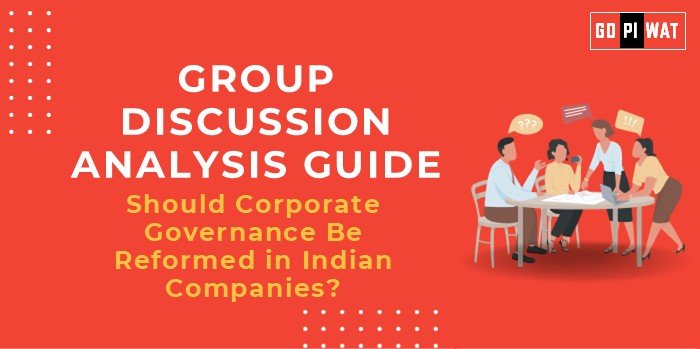📋 Group Discussion Analysis Guide
🌟 Topic: Should Corporate Governance Be Reformed in Indian Companies?
🌐 Introduction to Corporate Governance Reform
Corporate governance refers to the system by which companies are directed and controlled. Recent scandals like IL&FS and Yes Bank have highlighted significant gaps in India’s governance framework, reigniting calls for reform to enhance transparency, accountability, and investor confidence.
📊 Quick Facts and Key Statistics
- 💰 IL&FS Crisis (2018): ₹91,000 crore debt default due to mismanagement.
- 🏦 Yes Bank Collapse (2020): Regulatory gaps led to risky lending practices.
- 📈 Independent Directors: Only 51% of Nifty 500 companies meet SEBI’s requirements.
- 👩💼 Women Directors: Represent 18% of board positions, below the 30% target.
- 🌍 Global Rank: India ranks 49th in Corporate Governance on the World Economic Forum’s Global Competitiveness Index.
👥 Stakeholders and Their Roles
- ⚖️ Government Bodies: Enforce regulations and ensure compliance.
- 🏢 Company Boards: Promote transparency and ethical practices.
- 💼 Investors: Demand accountability and governance improvements.
- 📊 Auditors: Validate financial reports as external checks.
- 👩🏫 Employees & Public: Directly impacted by governance practices.
🏆 Achievements and Challenges
✨ Achievements:
- ✅ Introduction of independent directors for impartial oversight.
- ✅ Mandatory inclusion of women directors promoting inclusivity.
- ✅ Digital reporting and auditing enhancing transparency.
- ✅ Rise in shareholder activism improving checks on management.
⚠️ Challenges:
- ❌ Lack of board independence; independent directors often influenced by promoters.
- ❌ Regulatory loopholes delay timely enforcement.
- ❌ Weak audit practices and lack of stringent penalties.
- ❌ Promoter dominance in family-run businesses creating conflicts of interest.
🌍 Global Comparisons
- 🇺🇸 USA: Sarbanes-Oxley Act introduced stringent audit oversight post-Enron scandal.
- 🇬🇧 UK: Cadbury Report (1992) set global standards for board independence.
📖 Case Study: GE’s Crotonville leadership program improved decision-making efficiency and profitability, serving as a global benchmark.
📜 Structured Arguments for Discussion
- ✅ Supporting Stance: “Reforming governance is crucial to prevent fraud, build trust, and align with global best practices.”
- ❌ Opposing Stance: “India has robust regulations; the real challenge lies in weak implementation.”
- ⚖️ Balanced Perspective: “While frameworks exist, reforms should address enforcement gaps and promote autonomy in decision-making.”
💡 Effective Discussion Approaches
- 📊 Statistical Start: “India’s corporate governance rank of 49 highlights urgent gaps in board independence and audit practices.”
- 🛠️ Counter-Argument Handling: Emphasize stricter enforcement and learning from global models like Sarbanes-Oxley.
📈 Strategic Analysis of Strengths and Weaknesses
- Strengths: Strong SEBI guidelines; increased shareholder activism.
- Weaknesses: Board autonomy and enforcement gaps.
- Opportunities: Adopting global best practices and improving audit independence.
- Threats: Promoter biases and regulatory resistance.
🎓 Connecting with B-School Applications
- Real-World Applications: Analyze governance failures like IL&FS and Satyam for strategy projects.
- Sample Interview Questions: “How can governance reforms enhance investor confidence in India?”
- Insights for B-School Students: Build frameworks emphasizing transparency, stakeholder trust, and ethical leadership.


